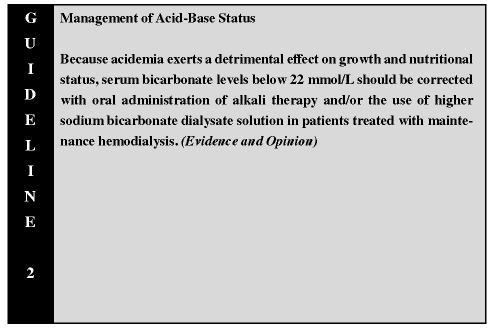

Metabolic acidosis (total venous carbon dioxide content less than 20 mmol/L) was encountered in one half of children 5 to 17 years of age who were treated with MHD. In only 50% of these patients was acidosis corrected after an HD treatment.16 Patients treated with peritoneal dialysis have more normal serum bicarbonate levels than do patients receiving chronic HD.17 Acidosis may play a significant role in the continuing growth retardation in children with end-stage renal disease (ESRD), despite the appropriate use of vitamin D metabolites to reverse secondary hyperparathyroidism.
The beneficial effect of correction of acidosis on growth retardation was initially described in children with renal tubular acidosis and normal renal function.18 Such results have been extrapolated to patients with ESRD. However, there are no published data that specifically address the effects of acidosis on growth in MD patients. Blunted GH response to a standard clonidine stimulus has been demonstrated in children with renal tubular acidosis. The often-profound growth failure seen in these patients has been thought to be secondary to inhibition of GH secretion or expression in the presence of chronic metabolic acidosis. In addition, the degree of acidosis has a significant influence on proteolysis in human volunteers and experimental animals.19,20
Recent experimental data support the contention that the growth retardation of acidosis is related to the primary effect of acidosis on the GH/IGF axis, primarily by altering the pattern of GH secretion.21 Metabolic acidosis not only reduces pulsatile pituitary secretion of GH, but also decreases hepatic GH-receptor mRNA and IGF-I mRNA. In addition, acidosis directly reduces IGF-I expression in chondrocytes of the growth plate of the long bone in experimental animals.
In acidotic uremic animals, depressed serum IGF-I levels returned to normal with sodium bicarbonate correction of the uremic acidosis. Significantly, the food intake did not differ between the uremic nonacidotic and the uremic acidotic group.22 These multiorgan effects of metabolic acidosis may explain the growth failure observed in children who are acidotic, including those receiving MD.
It is recommended, therefore, that serum bicarbonate levels below 22 mmol/L be corrected in all children treated with MD. The use of high sodium bicarbonate concentrations in dialysate as well as oral administration of sodium citrate or sodium bicarbonate to maintain steady-state serum bicarbonate levels should be individualized. Attention should be paid to the potential concomitant use of aluminum containing antacids and sodium citrate, because citrate salts enhance intestinal absorption of aluminum and thus the risk of aluminum intoxication.